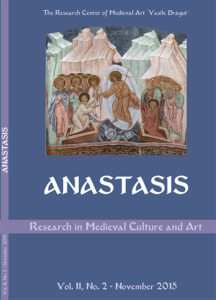La scène de la Crucifixion dans certaines versions du cycle de l’Acathiste et l’impact des icônes crétoises sur l’iconographie moldave
The Scene of the Crucifixion in Certain Versions of the Cycle of the Acathist and the Impact of Cretan Icons on Moldavian Iconography
Author(s): Athanasios SemoglouSubject(s): Fine Arts / Performing Arts, Visual Arts, Theology and Religion, Eastern Orthodoxy
Published by: Editura ARTES
Keywords: hymne Acathiste; hymnographie; iconographie mariale; Vierge; icônes crétoises; Crucifixion; En toi se réjouit; Moldavie
Summary/Abstract: The illustration of the 18th stanza (oikos) of the Akathistos Hymn by the composition of the Crucifixion in some Moldavian monuments is an exceptional iconographic detail. The monuments are St. Nicolas of Probota monastery, St. George of St. John the New in Suceava and the Dormition of the Virgin in Humor. It is relevant to mention the Church of St. Onuphrio's Lavrov monastery in Western Ukraine as well. The composition of the Crucifixion as the stanza of the Akathistos Hymn is met only to illustrate the 13th stanza the oikos N, in some icons of the Cretan painters Georgios Klontzas and Theodoros Poulakis. These icons illustrate the Marian hymn composed by John Damaskenos "All of Creation rejoices in thee" (Ἐπί σοί χαίρει) sung during the celebration of the Liturgy of Saint Basil. Its subject is the glorification of the Virgin and appears in several murals in the Balkans and Russia as well as in Cretan and Russian icons from the 15th c. The Crucifixion as an illustration of the 13th oikos is found in the Klontzas icon kept in the museum of the Hellenic Institute in Venice (second half of the 16th c) and in that of Poulakis in the Benaki Museum in Athens (second half of the 17th c). These works are combining the hymn of the Virgin with the Christological cycle enriched by the episodes of the Passion, the stanzas of the Akathistos Hymn and the assembly of archangels, apostles, saints hierarchs, monks and prophets. The scene of the Crucifixion with the three main persons, Christ, Virgin and St. John, is included in a dome crowning the central composition arranged in concentric circles. The contamination of the Moldavian examples by the iconography of the Cretan icons appears to be certain not only because of the specificity of the choice. The additional argument on the hypothesis is provided by the incorporation of the "All of Creation rejoices in thee" composition in the cycle of the Akathistos to the Moldavian monuments. The fixed presence of the composition "All of Creation rejoices in thee" reflects the popularity of the Marian hymn and the penetration of the iconography of Cretan icons in the Moldavian art. The common hymnographic field seems to have favored the intermingling of the two hymns that glorify the Virgin. It is only through this intersection of the two subjects that Crucifixion was paradoxically inserted into the image of the hymn "All of Creation rejoices in thee". Apart from the extraordinary illustration of the Crucifixion, the Moldavian examples share with the Cretan icons the same effort to merge the two hymns and build an illustrating story of a collective prayer to the Virgin in order to accomplish the eschatological prophecies and fulfill the visions and political ambitions.
Journal: Anastasis Research in Medieval Culture and Art
- Issue Year: II/2015
- Issue No: 2
- Page Range: 72-87
- Page Count: 16
- Language: French

